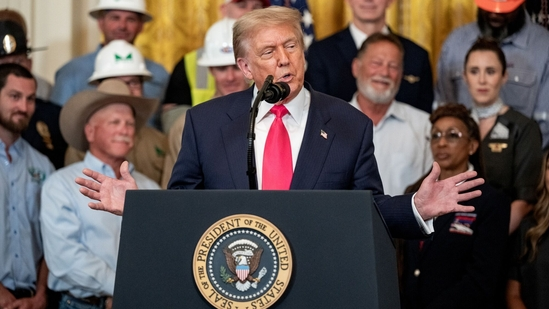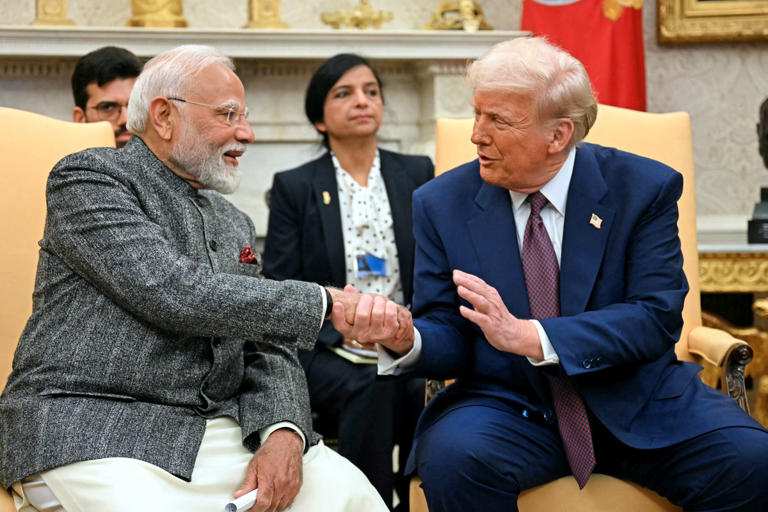Why Is Trump Doubling Down on a US-India Trade Agreement?
On June 26, 2025, US President Donald Trump announced a trade deal with China and hinted at a “very big” trade agreement with India.

Speaking at the White House, Trump suggested negotiations with India are advancing fast. The deal aims to boost economic ties, but details remain unclear.
This follows a February 2025 meeting between Trump and Indian Prime Minister Narendra Modi, where both leaders agreed to finalize the first phase of a bilateral trade pact by autumn 2025.
Background of the Trade Talks
The US and India have been negotiating a trade deal since early 2025. Talks accelerated after Trump paused reciprocal tariffs until July 9, 2025.
India seeks tariff stability, especially for its pharmaceutical and software exports. However, disagreements over auto components, steel, and farm goods have slowed progress.
India’s data localization rules and high tariffs on US dairy and medical equipment are also sticking points. Both nations aim to expand bilateral trade to $500 billion by 2030, up from $191 billion in 2024.
Modi’s Push for a Big Trade Deal
Prime Minister Modi is keen to strengthen India’s economic ties with the US. He sees the deal as a way to boost India’s exports, particularly in pharmaceuticals, garments, and electronics.
Modi’s government has offered tariff cuts on farm products and preferential treatment for US firms. The deal aligns with India’s strategy to diversify trade partners amid tensions with China.
Modi also aims to leverage the US to counterbalance China’s regional influence. A successful deal could solidify India’s role as a key US ally in the Indo-Pacific.
India-US Relations Under Trump in 2025
Since Trump took office in 2025, India-US relations have seen ups and downs. The February 2025 Modi-Trump meeting set a positive tone, focusing on trade and defense cooperation.
However, Trump’s claim of mediating a ceasefire between India and Pakistan caused friction, with India denying US involvement.
India remains cautious about Trump’s erratic trade policies and his perceived tilt toward Pakistan. Despite this, both nations prioritize countering China’s rise, with India hosting the 2025 Quad Summit. The trade deal is a cornerstone of this strategic partnership.
India-US Trade Data Snapshot
In 2024, India-US bilateral trade reached $191 billion. India enjoys a $37 billion trade surplus with the US, its largest export market for software services.
Key Indian exports include pharmaceuticals, garments, and engineering goods. The US exports energy, defense equipment, and farm products to India. Both countries aim to grow trade to $500 billion by 2030. However, US tariffs, including 50% on steel and 25% on autos, threaten Indian exporters. India’s tariff advantage over competitors like Vietnam and China helps soften the blow.
China’s trade truce with the US, signed in June 2025, has shaped the India-US talks. The deal, based on a Geneva framework, includes China supplying rare earth minerals and magnets.
It eased global market tensions after months of tariff hikes. However, China’s recent restrictions on agriculture shipments to India, while continuing exports to others, have strained India-China ties. India sees the US deal as a way to reduce reliance on China, where it faces an $85 billion trade deficit.
Trump’s focus on “opening up” China and India suggests a broader strategy to rebalance global trade.


 DRC President May Nominate Trump for Nobel Peace Prize
DRC President May Nominate Trump for Nobel Peace Prize  Why Zohran Mamdani Faces Accusations of Anti-India Sentiment
Why Zohran Mamdani Faces Accusations of Anti-India Sentiment  Zelenskyy Goes Formal for Trump After Oval Office Tensions
Zelenskyy Goes Formal for Trump After Oval Office Tensions  Sharif’s Dialogue Call: A New Chapter or Old Promises?
Sharif’s Dialogue Call: A New Chapter or Old Promises?  U.S. Resumes Student Visa Interviews with Social Media Rule
U.S. Resumes Student Visa Interviews with Social Media Rule  Why Is Trump Positioning the U.S. for an Iran Strike?
Why Is Trump Positioning the U.S. for an Iran Strike?